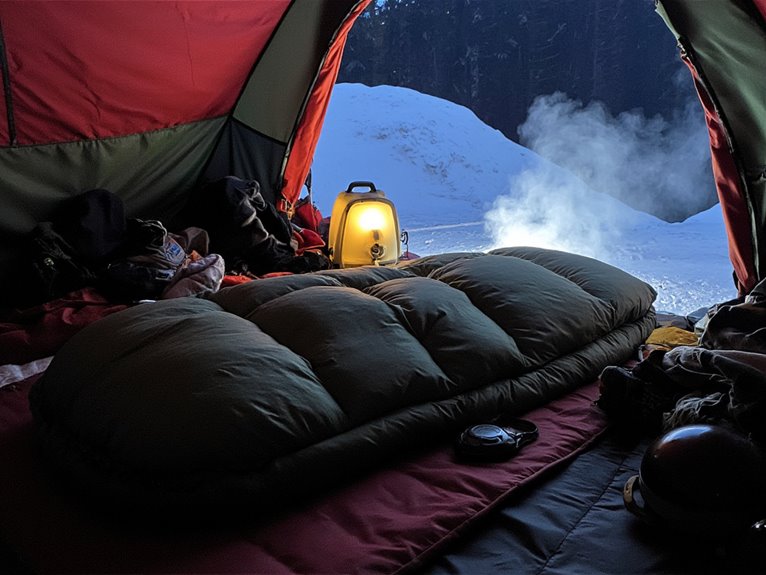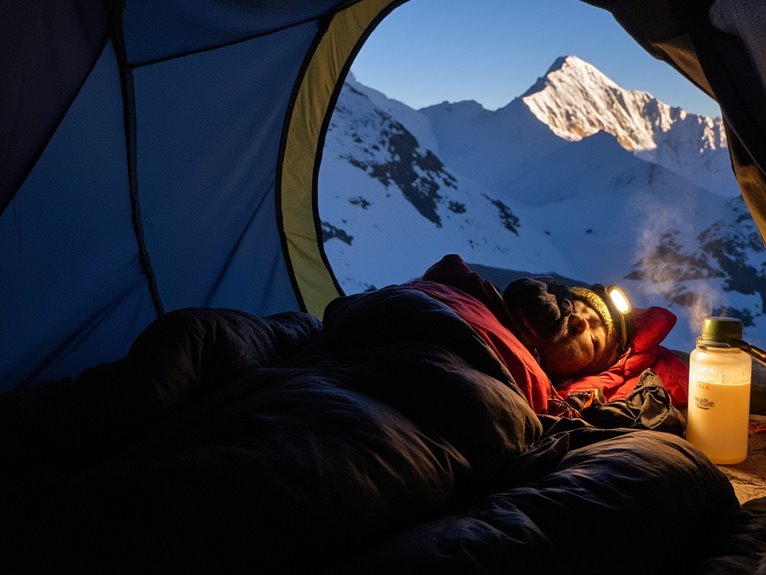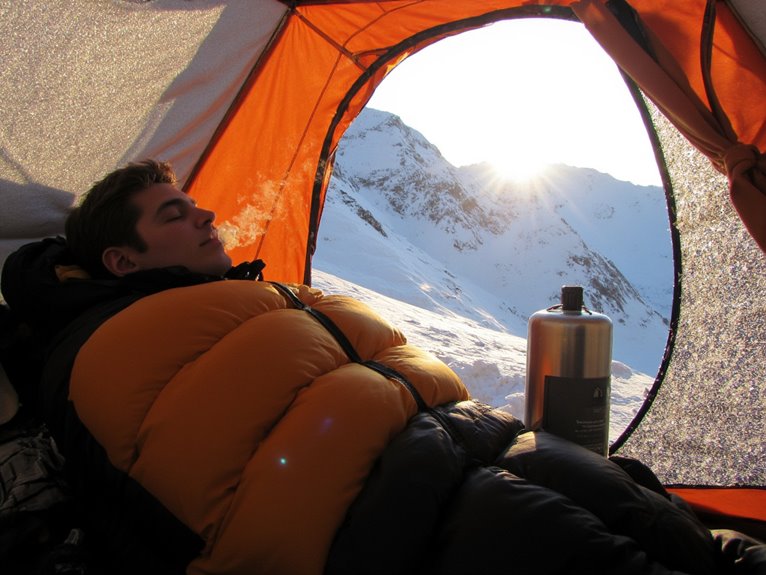How to Sleep Better at Altitude: Oxygen, Warmth, and Comfort
You’ll sleep better at altitude by managing three critical factors: oxygen, warmth, and comfort. Use acetazolamide to prevent breathing disruptions and maintain oxygen saturation above 90%. Invest in 4-5 inch insulated sleep pads and layered bedding systems to combat temperature drops of 3.5°F per 1,000 feet elevation. Ascend gradually—no more than 1,600 feet daily sleeping elevation increases. Stay hydrated with an extra 1-1.5 liters daily and avoid alcohol before bed. Master these fundamentals to reveal advanced altitude sleep optimization techniques.
We are supported by our audience. When you purchase through links on our site, we may earn an affiliate commission, at no extra cost for you. Learn more. Last update on 9th December 2025 / Images from Amazon Product Advertising API.
Notable Insights
- Use acetazolamide or supplemental oxygen therapy to combat reduced oxygen levels and prevent periodic breathing disruptions.
- Sleep with your head slightly elevated and on your side to facilitate easier breathing and airway management.
- Invest in insulated bedding systems with 4-5 inch thick sleep pads to maintain core temperature against cold ground.
- Ascend gradually, limiting sleeping elevation increases to 1,600 feet daily and taking rest days every 3,300 feet gained.
- Increase daily fluid intake by 1-1.5 liters and focus on high-carbohydrate meals while avoiding alcohol and sedatives.
Understanding Oxygen Levels and Altitude Effects on Sleep
The shift from sea level to high altitude triggers a cascade of physiological changes that directly impact your sleep quality. At elevations above 8,000 feet, barometric pressure drops considerably. This reduces oxygen concentration in the air you breathe.
High altitude’s reduced barometric pressure creates a physiological domino effect that fundamentally alters your body’s sleep patterns.
Your oxygen saturation levels decrease from the normal 95-100% to potentially 85-90% or lower. Your body responds by increasing respiratory rate and redistributing blood flow to essential organs. However, these compensatory mechanisms disrupt normal sleep architecture.
You’ll experience more frequent awakenings and lighter sleep stages. Deep, restorative slow-wave sleep becomes reduced.
Altitude adaptation occurs over days to weeks through enhanced red blood cell production. Your body increases erythropoietin hormone levels, boosting oxygen-carrying capacity.
Until this process completes, expect continued sleep disruptions and daytime fatigue.
Managing Cold Temperatures and Sleep Environment

Beyond oxygen deprivation, cold temperatures at high altitudes create a secondary challenge that can sabotage your sleep quality.
Temperature drops approximately 3.5°F per 1,000 feet of elevation gain. Your body’s thermoregulation techniques must work harder in these conditions, consuming energy that should support restorative sleep.
Effective altitude sleep management requires three critical components:
- Insulated bedding systems – Use sleeping bags rated 10-15°F below expected temperatures with R-values above 4.0 for ground insulation.
- Layered sleep apparel – Wear moisture-wicking base layers with merino wool mid-layers to maintain core temperature without overheating.
- Climate control solutions – Deploy portable heaters with automatic shut-off features or heated sleeping pads drawing 20-40 watts.
Proper ventilation remains essential.
Sealed environments create condensation that reduces insulation effectiveness and increases heat loss.
Women should consider sleeping bags with even warmer ratings, as they typically require bags rated 10-15 degrees warmer than standard temperature recommendations for optimal thermal comfort.
Essential Gear for Comfortable High-Altitude Rest
Your gear selection directly impacts sleep quality at high altitudes where environmental challenges can quickly turn a restful night into a miserable experience.
You’ll need three critical categories of equipment: quality sleep pads that provide adequate insulation from cold ground temperatures, temperature-regulating gear that adapts to fluctuating nighttime conditions, and breathing support products that help your body adjust to reduced oxygen levels.
These specialized items work together to create a sleep system that counters altitude’s primary threats to rest.
For optimal comfort and support, choose sleeping pads with 4-5 inches of thickness, as this provides crucial cushioning against rocky terrain while maintaining proper insulation from the cold ground.
Quality Sleep Pads
When sleeping at altitude, a quality sleep pad becomes your primary defense against cold ground that can sap body heat and create uncomfortable pressure points on rocky terrain.
You need 4.6 inches of padding and an R-value of 4.7 for effective insulation. The 50-denier polyester fabric provides durability without excessive weight at 1 pound 8.9 ounces.
Essential sleep pad features include:
- Thick cushioning – 4.6-inch padding supports side sleepers and accommodates various body types on uneven surfaces
- Built-in side rails – Prevent rolling off during sleep while maintaining stability throughout the night
- Stretch-knit fabric – Conforms closely to body shape, enhancing overall comfort and heat distribution
Proper pad maintenance requires checking sealed seams and valve attachments regularly.
Industry leaders like Therm-a-Rest offer reliable options for high-altitude conditions.
Temperature Regulating Gear
A quality sleep pad alone won’t keep you warm when temperatures plummet at high altitudes—your entire thermal system must work together to maintain comfortable sleeping conditions.
Your sleeping bag serves as the cornerstone of effective temperature regulation techniques. Down insulation provides superior warmth-to-weight ratios but loses efficiency when damp. Synthetic fills maintain insulation properties even in wet conditions, making them reliable for unpredictable mountain weather.
Layer your clothing systematically using proven insulation materials. Fleece mid-layers offer consistent warmth, while Primaloft synthetic insulation resists moisture better than down alternatives.
Merino wool base layers excel at moisture management. Your outer shell must be both waterproof and breathable—Gore-Tex fabrics meet these requirements effectively.
Don’t overlook thermal accessories. Insulated socks, gloves, and hats prevent heat loss from extremities where blood circulation naturally decreases at altitude.
Breathing Support Products
While temperature regulation keeps your body warm, oxygen deficiency remains the primary culprit behind restless nights at elevation—and specialized breathing support products can provide the respiratory assistance you need for quality sleep.
Essential breathing support options include:
- Portable oxygen canisters – Boost Oxygen delivers 95% pure oxygen versus air’s 21% concentration, providing immediate altitude recovery in a lightweight package the size of a Pringles can.
- Medical-grade oxygen concentrators – These devices selectively filter nitrogen to increase oxygen concentration, requiring electricity but offering sustained respiratory health support for extended stays.
- Breathing muscle training devices – POWERbreathe systems strengthen respiratory muscles through resistance training, improving lung efficiency and breathing techniques for better high-altitude performance without supplying additional oxygen.
Gradual Ascent and Acclimatization Strategies

Three fundamental principles govern successful altitude acclimatization: controlled ascent rates, strategic rest periods, and physiological monitoring. You shouldn’t increase your sleeping elevation by more than 1,600 feet daily. This measured approach reduces acute mountain sickness risk considerably.
Implement the 3,300-foot rule for ideal altitude adaptation. Add one rest day for every 3,300-foot elevation gain. Your body requires this time to adjust oxygen-carrying capacity and respiratory function.
Personalized planning proves essential since adaptation rates vary greatly between individuals. Monitor your symptoms continuously—headaches, nausea, or fatigue signal necessary schedule adjustments. Track sleeping elevations precisely at each stage.
Pre-ascent conditioning hikes prepare your cardiovascular system effectively. Start hydration protocols before arriving at altitude. Consume 3-4 liters daily throughout your climb.
Plan emergency descent routes should severe symptoms develop unexpectedly.
Breathing Patterns and Sleep Disruption Solutions
Even with perfect acclimatization timing, your breathing patterns will fundamentally change at altitude, creating sleep disruptions that require specific solutions.
Above 2,500 meters, you’ll experience periodic breathing cycles alternating between apnea and hyperventilation. This occurs because hypobaric hypoxia triggers increased respiration, followed by hypocapnic alkalosis that suppresses breathing entirely.
Three proven strategies address these breathing patterns:
- Acetazolamide administration – This carbonic anhydrase inhibitor reduces hypoxemia and improves sleep architecture when started before severe disruption occurs.
- Supplemental oxygen therapy – Direct oxygen delivery minimizes periodic breathing cycles and nocturnal hypoxemia.
- Sleep position optimization – Elevate your head slightly and sleep on your side to facilitate easier breathing mechanics.
These interventions target the root physiological mechanisms rather than masking symptoms.
Hydration, Diet, and Substance Considerations
Why does your body’s fluid balance become so critical at altitude when sleep quality hangs in the balance? Cold, dry air increases moisture loss through respiration while frequent urination above 8,200 feet depletes fluids further. Your kidneys excrete bicarbonate to balance blood pH, creating additional water loss. Dehydration worsens altitude symptoms like headaches and fatigue, directly disrupting sleep.
Effective hydration strategies require drinking 8 ounces every 30 minutes during activity, plus increasing daily intake by 1-1.5 liters. Monitor urine color as your hydration indicator.
| Beneficial Practices | Practices to Avoid |
|---|---|
| High carbohydrate intake for easy energy | Heavy, greasy meals before sleep |
| Small, frequent meals for stable blood sugar | Excessive alcohol consumption |
| Moderate caffeine with careful timing | Sedative medications without medical guidance |
| Electrolyte-containing fluids for balance | Overhydration leading to hyponatremia |
Smart dietary adjustments support better sleep at altitude.
Recognizing and Preventing Altitude Sickness Symptoms
You can’t achieve quality sleep at altitude if you’re battling acute mountain sickness (AMS), which typically begins with persistent headaches, nausea, and fatigue within 6-12 hours of arrival above 8,200 feet.
The key to prevention lies in ascending no more than 1,600 feet per day above 8,200 feet and spending at least one acclimatization day for every 3,000 feet gained.
Recognizing early warning signs like difficulty concentrating, loss of appetite, and disturbed sleep patterns allows you to implement immediate countermeasures before symptoms worsen and completely disrupt your rest.
Early AMS Warning Signs
Early detection requires monitoring these specific indicators:
- Neurological symptoms – Headache intensity increases progressively, accompanied by nausea and persistent fatigue that doesn’t improve with rest.
- Cognitive impairment – Disorientation, poor decision-making, and confusion indicate oxygen saturation below 90% at sea level equivalent.
- Respiratory compromise – Shortness of breath during minimal exertion or at rest, combined with digestive issues like appetite loss.
Recognition within 6-12 hours enables prompt intervention before symptoms escalate.
Gradual Ascent Strategy
When ascending to high altitudes, implementing a controlled ascent strategy reduces altitude sickness risk by up to 75% compared to rapid elevation gains. Your body requires time for altitude acclimatization to adjust to decreasing oxygen levels and air pressure changes.
Follow strict elevation limits during gradual elevation increases. Don’t exceed 1,600 feet per day for sleeping elevation above 8,200 feet. Spend 2-3 days below 8,200 feet before ascending higher.
| Elevation Range | Daily Ascent Limit | Acclimatization Days |
|---|---|---|
| Below 8,200 ft | No restriction | 0-1 |
| 8,200-11,000 ft | 1,500 ft/day | 1-2 |
| 11,000-14,000 ft | 1,000 ft/day | 2-3 |
| Above 14,000 ft | 500 ft/day | 3+ |
| Extreme altitude | Expert guidance | Variable |
Begin acclimatization at moderate elevations like Denver. Avoid flying directly to high-altitude destinations whenever possible.
Symptom Management Techniques
How can altitude sickness symptoms be identified early enough to prevent serious complications?
You’ll typically experience headaches, nausea, fatigue, and dizziness within 24 hours of reaching high elevations. These early warning signs shouldn’t be ignored or misdiagnosed as dehydration.
Effective symptom management requires immediate action:
- Descent Protocol: Drop 1,000-2,000 feet immediately when moderate symptoms like vomiting or severe shortness of breath appear.
- Medication Administration: Take acetazolamide 125-250mg twice daily for symptom relief, or dexamethasone 4mg every six hours for severe cases.
- Supplemental Oxygen: Use 2-4 liters per minute oxygen flow to maintain blood oxygen saturation above 90%.
Avoid sleep aids that depress respiratory function.
Instead, focus on natural symptom relief through proper positioning and controlled breathing techniques to maintain adequate sleep quality.



